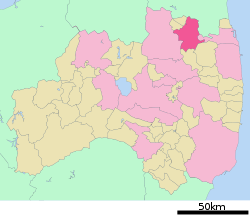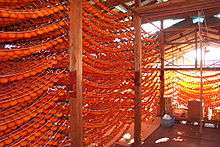Date, Fukushima
Date (伊達市, Date-shi) is a city in Fukushima Prefecture, Japan. As of 31 May 2020, the city had an estimated population of 59,625 in 22,843 households and a population density of 220 persons per km2. The total area of the city was 265.10 square kilometres (102.36 sq mi).[1]
Date 伊達市 | |
|---|---|
 Date City Hall | |
Flag  Seal | |
 Location of Date in Fukushima Prefecture | |
 Date | |
| Coordinates: 37°49′8.9″N 140°33′46.7″E | |
| Country | Japan |
| Region | Tōhoku |
| Prefecture | Fukushima |
| Area | |
| • Total | 265.12 km2 (102.36 sq mi) |
| Population (May 31, 2020) | |
| • Total | 59,625 |
| • Density | 220/km2 (580/sq mi) |
| Time zone | UTC+9 (Japan Standard Time) |
| - Tree | Pinus densiflora |
| - Flower | Peach |
| - Bird | Wagtail |
| Phone number | 024-575-2570 |
| Address | 180 Hobaramachi aza Funabashi, Date-shi, Fukushima-ken 960-0692 |
| Website | Official website |
Geography
Date occupies the eastern half of the Fukushima Basin in northern Fukushima prefecture, with Miyagi Prefecture on its northern border. The area was once noted for sericulture but transitioned to fruit cultivation during the Taishō period. It is currently organized into the five former towns of Date, Hobara, Yanagawa, Ryozen, and Tsukidate, each of which retain numerous unique traditions and events. Hobara is the central area, where the municipal government is based.[2]
- Rivers: Abukuma River, Hirose River
Climate
Date has a humid climate (Köppen climate classification Cfa). The average annual temperature in Date is 12.8 °C (55.0 °F). The average annual rainfall is 1,227 mm (48.3 in) with September as the wettest month.The temperatures are highest on average in August, at around 25.5 °C (77.9 °F), and lowest in January, at around 1.4 °C (34.5 °F).[3]
Demographics
Per Japanese census data,[4], the population of Date has declined over the past 70 years.
| Year | Pop. | ±% |
|---|---|---|
| 1950 | 80,527 | — |
| 1960 | 76,361 | −5.2% |
| 1970 | 73,767 | −3.4% |
| 1980 | 74,186 | +0.6% |
| 1990 | 74,200 | +0.0% |
| 2000 | 71,817 | −3.2% |
| 2010 | 66,027 | −8.1% |
History
A whole body skeleton of Paleoparadoxia was excavated in Yanagawa on August 21, 1984. The skeleton is named the “Yanagawa Specimen”. The first humans to live within the bounds of present-day Date City are thought to have arrived during the Paleolithic Period. The area was part of ancient Mutsu Province. Towards the end of the Heian Period, Shinobu-gun (present day Fukushima City) and Date-gun (encompassing not only present day Date, but also Koori Town to the North and Kawamata Town to the South) were awarded to Date Tomomune.[5] Tomomune founded the Date clan in present-day Hobara. The 17th lord of the Date Clan, Date Masamune lost control of the area and went on to found the Sendai Clan and the City of Sendai.[5] The clan continued to rule over the Sendai Domain during the Edo period. However, under the Edo period Tokugawa shogunate, most of the area of Date was initially part of Yonezawa Domain, followed by Fukushima Domain and Yanagawa Domain before becoming tenryō territory under direct control of the shogunate. It was not part of the Date Clan's territories. After the Meiji Restoration, the area was organized as part of Nakadōri region of Iwaki Province.
As of 1889, at the time of the establishment of the modern municipalities system, the area consisted of 21 towns and villages. Between the years 1955 and 1960, these were consolidated into the five towns of Date (formerly the villages of Nagaoka and Fushiguro), Hobara (formerly the town of Hobara and the villages of Ooda, Kamihobara, Hashirazawa, and Tominari), Ryōzen (formerly the villages of Ryozen, Kakeda, Oguni, and Ishido), Tsukidate (formerly the villages of Ote and Otegawa), and Yanagawa (formerly the town of Yanagawa and the villages of Awano, Sekimoto, Shirane, Ooeda, Isazawa, Tomino, and Yamafunyuu), which merged to create the modern city of Date on January 1, 2006.[5]
Date is about 60 kilometres (37 miles) north-west of Fukushima I Nuclear Power Plant, the site of the nuclear accident that followed the 2011 Tōhoku earthquake and tsunami. Although outside the nuclear accident exclusion zone, the levels of radiation in the city caused residents, and especially children, to remain indoors.[6]
In 2016 an anime was produced in promotion of the city. Masamune Datenicle (政宗ダテニクル) features a young Date Masamune who meets a dragon deity that gives him the ability to call upon former leaders of the Date Clan.[7]
Government
Date has a mayor-council form of government with a directly elected mayor and a unicameral city legislature of 22 members. Date, together with the three municipalities of Date District, collectively contribute three members to the Fukushima Prefectural Assembly. In terms of national politics, the city is part of Fukushima 1st district of the lower house of the Diet of Japan.
Economy
The economy of Date is primarily agricultural, with an emphasis on rice and horticulture. The area is noted for its peaches and dried persimmons. Taiyo Yuden operates a CD and DVD production plant in the Yanagawa Industrial Zone in Date, Fukushima.
Peaches
Date City's location in central Fukushima (Nakadōri), in the middle of Fukushima Basin, helps in the cultivation of peaches. The most common varieties grown in the area are Akatsuki, Kawanakajima, and Yuuzora.[8]
Dried Persimmons
As sericulture lost its place in the area during the Taisho period, the former village of Isazawa in Yanagawa replaced it with the production of dried persimmons, among other industries. Dried persimmons had been produced in the area since the Edo Period. However, the addition of sulfur fumigation as was used in the production of raisins in the United States, allowed for a much sweeter product. Whereas traditional dried persimmons, hoshigaki, have a tough skin and are almost black in color, those created with the additional step of sulfur fumigation, called anpogaki or tsurushigaki, are soft and bright orange.

Although the production of anpogaki was halted for three years after the 2011 disaster, Date City's persimmon orchards have since been decontaminated and testing machines have been installed, ensuring the safety of the final product.[9]
Education
Date City has fifteen public elementary schools, six public junior high schools, two public high schools, and one private high school:[10]
| Area | Public/Private | School |
|---|---|---|
| Date | Public | Date Elementary (伊達小学校) |
| Public | East Date Elementary (伊達東小学校) | |
| Yanagawa | Public | Yanagawa Elementary (梁川小学校) |
| Public | Awano Elementary (粟野小学校) | |
| Public | Sekimoto Elementary (磧本小学校) | |
| Hobara | Public | Hobara Elementary (保原小学校) |
| Public | Ota Elementary (大田小学校) | |
| Public | Kamihobara Elementary (上保原小学校) | |
| Public | Hashirazawa Elementary (柱沢小学校) | |
| Ryōzen | Public | Kakeda Elementary (掛田小学校) |
| Public | Oishi Elementary (大石小学校) | |
| Public | Ishida Elementary (石田小学校) | |
| Public | Oguni Elementary (小国小学校) | |
| Tsukidate | Public | Tsukidate Elementary (月舘小学校) |
| Public | Ōte Elementary (小手小学校) |
| Area | Public/Private | School |
|---|---|---|
| Date | Public | Date Middle School (伊達中学校) |
| Yanagawa | Public | Yanagawa Middle School (梁川中学校) |
| Hobara | Public | Shōyō Middle School (松陽中学校) |
| Public | Tōryō Middle School (桃陵中学校) | |
| Ryōzen | Public | Ryōzen Middle School (霊山中学校) |
| Tsukidate | Public | Tsukidate Middle School (月舘中学校) |
| Area | Public/Private | School |
|---|---|---|
| Hobara | Public | Hobara High School (福島県立保原高等学校) |
| Yanagawa | Public | Yanagawa High School (福島県立梁川高等学校) |
| Date | Private | Seikō Gakuin High School (私立聖光学院高等学校) |
Transportation
Railway
![]()
AbukumaExpress – Abukuma Express Line
- Takako - Kamihobara - Hobara - Ōizumi - Niida - Nitta - Yanagawa - Yanagawa Kibōnomori Kōen-mae - Tomino - Kabuto
Local attractions
- Ryōzen Shrine
- Mount Ryōzen, National Historic Site and National Place of Scenic Beauty
- Miyawaki temple ruins, National Historic Site [11]
- Former Kameoka Family Home
- Takako Ni-juu Kyou
- site of Takakogaoka Castle, the original home of the Date Clan
- Takako Lake, one of Takako Ni-juu Kyou
- site of Yanagawa Castle, constructed by the Date Clan and once home to Date Masamune[12]
- Yanagawa Hachiman Shrine, where Date Masamune prayed for victory in battle[13]
Notable people from Date
- Saitou Hikonai (斎藤彦内, 1709-1750) was a farmer and the leader of a peasants' revolt.
- Seishiro Okazaki (January 28, 1890 – July 12, 1951) was a Japanese American healer, martial artist, and the founder of Danzan-ryū jujitsu. Born in the former village of Kakeda, he immigrated to Hawaii in 1906.[14]
- Yahei Miura (弥平三浦, 1895-1971) was a long-distance runner and Olympic athlete.
International relations

.png)
External links
![]()
- Official website(in Japanese)
- Date City Commerce and Tourism Association Portal Site, "Date Megane" (in Japanese)
Notes
- "Date City official statistics" (in Japanese). Japan: Date city.
- "歴史めぐりマップ 生誕七百年 北畠顕家卿" (PDF). Date-shi.jp. Retrieved 4 January 2019.
- Date climate data
- Date population statistics
- "伊達市の歴史 - 福島県伊達市ホームページ". www.city.fukushima-date.lg.jp. Retrieved 2019-03-20.
- Takahiko Hyuga and Shigeru Sato (11 May 2011). "Fukushima Students Wear Masks as Radiation Looms". Bloomberg. Retrieved 11 May 2011.
- "Gainax Fukushima's Masamune Datenicle Web Series Holds 1st Talk Event in Tokyo". Anime News Network. Retrieved 2019-05-30.
- "伊達のもも - 福島県伊達市ホームページ". www.city.fukushima-date.lg.jp. Retrieved 2019-08-29.
- "Update from Coordinator for International Relations December 2017・国際交流員日記12月2017年 - 福島県伊達市ホームページ". www.city.fukushima-date.lg.jp. Retrieved 2019-01-04.
- "小学校・中学校・高等学校 - 福島県伊達市ホームページ". www.city.fukushima-date.lg.jp. Retrieved 2020-03-31.
- "宮脇廃寺跡" (in Japanese). Agency for Cultural Affairs.
- 梁川城跡及び庭園 - 福島県伊達市ホームページ. www.city.fukushima-date.lg.jp (in Japanese). Retrieved 2018-11-13.
- 旧梁川八幡宮並びに別当寺境域 - 福島県伊達市ホームページ. www.city.fukushima-date.lg.jp (in Japanese). Retrieved 2018-11-13.
- Citation error. See inline comment how to fix.
- "Guyana signals intent for Tokyo 2020 Olympics cultural exchange". Sports Hub GY. 2019-07-26. Retrieved 2019-08-28.